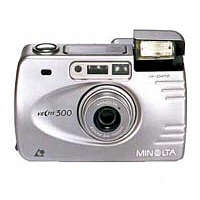Vectis 300
| Page Type | Gear Review |
|---|---|
| Object Title | Vectis 300 |
| Manufacturer | Minolta |
| Page By | Martin Cash |
| Page Type | Mar 6, 2003 / Jan 17, 2007 |
| Object ID | 693 |
| Hits | 6527 |
| Vote |
Minolta’s Vectis 300 BEAM is one great-looking compact camera. It combines Advanced Photo System technology, a powerful 3x zoom lens (approx. 30-87.5mm in the conventional 35mm format), and a host of high-performance features into a sleek and shimmering, stainless steel body. The matte-finish stainless steel provides a degree of refined elegance unmatched by conventional compact cameras. If you’re looking for something bold and beautiful, this is the one for you.
IX 240 lens-shutter camera.
Lens: 24-70mm stepless zoom (approx. 30-87.5mm in the 35mm format).
Aperture: f/5.7 - 9.8
Lens Construction: 4 elements, 4 groups.
Focusing Range: C,H: 1.3 ft. - infinity. P(T/W): 1.3 ft. - infinity/2.6 ft. - infinity.
Autofocus: External passive (wide focus area).
Focusing Steps: Approx. 560
Focus Lock: Available with the shutter-release button pressed partway down.
Autoexposure: Programmed AE.
Metering: Dual-segment metering (back-light detection by the AF sensor).
Shutter-Speed Range: 8-1/500 sec.
Metering Cell: SPC
Metering Range (ISO 200): EV 4-17
Film Speed Range: ISO 25 - 3200 (1/3 EV-stop increments)
Film Operation: Drop-in loading, auto threading, auto advance, auto rewind; mid-roll rewind selectable.
Frame Counter: Backward counter
DEP: Optical DEP
Film Chamber Lock: Yes; unlocked during rewind.
Viewfinder: Real-image zoom type.
Magnification: 0.35 - 0.91x
Diopter (for subject at 9.8 ft.): -1 diopter
Field-of-View (for H print): 85% for subject at 9.8 ft.
Eye Relief: 21.4mm from eyepiece, 19mm from eyepiece hood.
Flash: Built-in, retractable.
Autozoom: No
Flash Control: Electronic flash-matic with flash-intensity control.
Flash Range (at ISO 200): W: 1.3 - 14.4 ft.; T: 1.3 - 8.5 ft.
Guide Number: 42.6 feet at ISO 200.
Recycling Time: 0.3 - 5.5 sec.
Flash Modes: Autoflash (in low light, back light), autoflash with red-eye reduction, manual fill-flash, flash cancel, night portrait.
Red-Eye Reduction: Via flash.
Self-Timer: 10-second, cancelable.
Optional Remote Control: Infrared type; immediate shutter release and 2-second delay of shutter release available.
IX: Magnetic
PQI: Print Quality Improvement by using magnetic IX. Film orientation, flash/no flash, scene brightness value, artificial illuminant flag, magnification.
C/H/P Selection: External selection switch, by using IX data.
Date Imprinting: Magnetic IX: front and back imprinting available, using magnetic IX Year, month, date*/Hour, minute/No imprinting (Year, month, date*, hour, minute, are imprinted on back side). *Month,date,year/Date,month, year are also selectable.
Title Imprinting: User-select title (filmstrip, frame); Magnetic IX: 12 languages & 100 titles (following the system standards).
Battery: One 3V lithium CR2.
Battery-Condition Indicator: 3-stage indicator in data panel.
Battery Performance: Approx. 10 rolls, using 25-exposure film with flash on 50% of exposures.
Dimensions: 3.8 x 2.4 x 1.3 in.; (Remote Control): 1.2 x 2.5 x .2 in.
Weight: 7.5 oz. without battery; (Remote Control): .4 oz.
Images
Reviews
Viewing: 1-2 of 2 |
meepers - Dec 22, 2003 5:35 pm - Voted 1/5
Untitled Review
I took a brand new one to Denali. A week into the climb it failed. When I sent it back to be repaired they said it had sand in it and the repairs would cost more than its worth. The warrantee didn't cover the repairs. I didn't see any sand on Denali !!
Viewing: 1-2 of 2 |




Martin Cash - Mar 6, 2003 7:08 pm - Voted 1/5
Untitled ReviewThe biggest problem with the camera in that it doesn't take a picture of what is in the viewfinder. I took this to Central America and took 225 photos over 2 weeks of lots of different things. To my dismay, almost every shot cut out part of the subject matter. It does it randomly too. I took 2 shots of the Temple of the Jaguars in Tikal, Guatemala. They were both centered in the viewfinder. One has the right side cut off, and one the left. Unbelievable!
The other big problem is that the auto exposure almost always over or underexposes the picture, weather use you flash or not. The camera is pretty much useless indoor. The only thing that works half way decent is cloudy outdoor shots, if you can guess correctly what direction the camera is skewing the picture.
Another problem is the flash. The redeye reduction doesn't work at all, and it always leaves a bright spot.
A disposable camera takes much better shots than this piece of garbage. Avoid it like the plague.